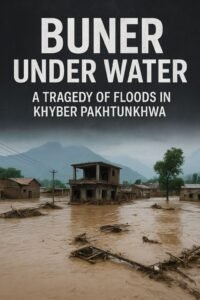
The serene valleys of Khyber Pakhtunkhwa witnessed one of the most devastating natural disasters in recent history. The district of Buner, known for its mountains, fertile lands, and peaceful villages, was struck by severe floods that turned prosperity into tragedy overnight.
According to initial reports, over 225 lives were lost, 120 people injured, and thousands displaced. The areas of Bishnoi, Batai, Kadir Nagar, Pir Baba Bazar, Gokand, and dozens of villages were submerged under furious floodwaters. This disaster not only washed away infrastructure but also tore apart the social and economic fabric of the region.
The Flood’s Fury
On the fateful night, heavy rains turned streams into raging rivers. The mountainous terrain of Buner amplified the force of water as it descended with unstoppable momentum.
•Houses collapsed within minutes.
•Roads and bridges vanished under torrents of water.
•Markets like Pir Baba Bazar drowned completely, leaving traders in despair.
•Schools and mosques crumbled, symbolizing the collapse of community lifelines.
•Agricultural fields, the primary source of livelihood, were buried under mud and stones.
Residents described the disaster as:
“A thunder that never stopped; a wave that destroyed everything in its path.”
Human Toll and Statistics
The numbers reveal the scale of suffering:
•Deaths: 225+ confirmed
•Injured: 120+
•Displaced Families: Hundreds now living in temporary shelters
•Infrastructure Damage: Roads cut off, bridges destroyed, communication lines down
•Livelihoods Lost: Thousands of acres of farmland destroyed, livestock swept away
Hospitals struggled to handle the influx of injured. With limited medicines and staff, local doctors worked tirelessly day and night.
Voices from Buner
The heart of this tragedy lies in the stories of survivors:
•A father from Kadir Nagar: “I lost my home, my shop, and my son. I stand here with nothing but grief.”
•A schoolteacher in Batai: “The school where I taught for 15 years has collapsed. What will happen to our children’s education?”
•A farmer in Gokand: “My fields are gone. Without them, I cannot feed my family. Hunger will kill us before the floods do.”
These voices show not only pain but also resilience, as communities come together to feed, shelter, and protect each other.
Government and Rescue Efforts
The Provincial Disaster Management Authority (PDMA), local administration, and armed forces quickly launched rescue operations.
•Helicopters airlifted stranded families.
•Trucks delivered food, medicine, and blankets.
•Volunteers and NGOs set up relief camps.
Yet, challenges remain:
•Many villages are still inaccessible.
•Compensation packages are announced but slow to reach victims.
•The real test lies ahead: reconstruction and rehabilitation.
Documentary-Style Narrative (If Used for Video/Report)
•Opening Scene: Aerial footage of submerged Buner, collapsed houses, and stranded families.
•Narration: “In the heart of Khyber Pakhtunkhwa, Buner stands shattered. The floods of 2025 have rewritten the history of this district in tears and destruction.”
•Cutaway Shots: Survivors weeping, children receiving food, volunteers clearing debris.
•Interviews: First-hand survivor accounts.
•Closing: “From loss rises resilience. The people of Buner need the nation’s hand to rebuild their tomorrow.”
Looking Ahead – Rebuilding and Lessons
To prevent such tragedies in the future, experts stress the need for:
1.Stronger Infrastructure – flood-resistant bridges, dams, and drainage systems.
2.Disaster Preparedness – early warning systems and training for communities.
3.Healthcare Improvements – better-equipped hospitals for emergencies.
4.Support for Farmers – compensation and seeds for new crops.
5.Education Restoration – rebuilding schools as a priority.
6.Global Assistance – collaboration with NGOs and international agencies for sustainable recovery.
Conclusion
The floods in Buner are not just a story of water and destruction—they are a reminder of human fragility in the face of nature, and the resilience that emerges from despair.
This tragedy has claimed more than 225 lives, but it has also ignited a call for unity, solidarity, and urgent action. Buner must not be left alone. With collective support, its people can rebuild their homes, their livelihoods, and their hope.
Writing by Shoaib butt

